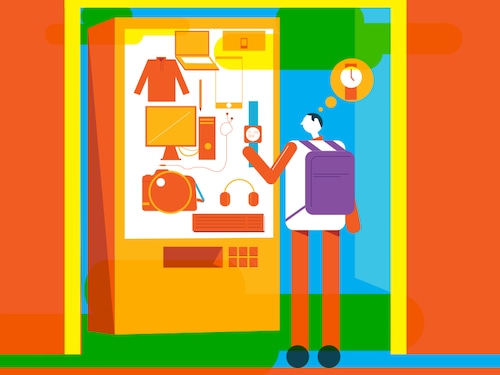'AI in retail is the next step': Big Basket's Hari Menon
In this decade, ecommerce will be powered by first-time internet users and small kirana shops


 Illustration: Smaeer Pawar[br]2010 was an exciting year for ecommerce. Among other innovations, smartphones and tablets started proliferating and, in no time, these devices became the de facto choice for people to make online purchases, inspiring a flurry of technological developments. This set the tone for a decade in which online retail exploded.
Illustration: Smaeer Pawar[br]2010 was an exciting year for ecommerce. Among other innovations, smartphones and tablets started proliferating and, in no time, these devices became the de facto choice for people to make online purchases, inspiring a flurry of technological developments. This set the tone for a decade in which online retail exploded. This was the phase during which we launched BigBasket, in 2011, at a time the estimated worth of the ecommerce market in India was pegged at $6.3 billion. By 2017, it grew to $38.5 billion and, by 2026, it is projected to touch $200 billion. As we step into the new decade, here’s my take on some definitive trends that will shape the Indian retail sector in the next few years, and pave the way for this growth.
This was the phase during which we launched BigBasket, in 2011, at a time the estimated worth of the ecommerce market in India was pegged at $6.3 billion. By 2017, it grew to $38.5 billion and, by 2026, it is projected to touch $200 billion. As we step into the new decade, here’s my take on some definitive trends that will shape the Indian retail sector in the next few years, and pave the way for this growth.
THE $50 MLN GOLDMINE
For a country with the second-highest base of internet users in the world, India surprisingly falls behind when it comes to the percentage of people who shop online. Today, just 10 percent of the 500 million active internet users in India shop online while the remaining prefer to use the internet only for product research, communication, entertainment and other purposes. What this means is that retailers are sitting on a virtual goldmine of potential customers and have the opportunity to tap into over $50 million worth of ecommerce transactions, driven by over 500 million first-timers to the internet and online shopping a majority of these users are from ‘Bharat’, the India of small towns and rural areas. According to a Google-AT Kearney report, by the end of next year, there would be around 175 million online shoppers in India.
The ecommerce market is being driven by electronics, fashion, and the grocery sector and the potential ahead for the players lies in adapting to the vast array and diversity of languages, given the promising return on investment offered for it. There is a huge scope for expansion in the smaller towns given that consumer trust is magnified when they see something in their native language. Realistically, however, this is not as simple as it sounds with digital illiteracy, prejudices and lack of customised content being some of the hurdles.
OMNI-CHANNEL RETAIL
This dominance of online commerce will also bring about a disruption in the traditional retail space with more small players adopting an omni-channel strategy. Kirana (mom-and-pop) stores form 88 percent of India’s retail universe and the motto will be embracing them instead of fighting it out. However, to stay relevant and compete with the big box retailers, more of these small retail outlets will turn to technology to drive their operations, either through apps, point of sale (POS) machines, digital payments solutions and inventory management solutions. Eventually, all the small stores will start offering their services and products online while maintaining their offline presence. Technology will not only give them an opportunity to connect to a wider consumer base, but also bring the science of retailing to them.
"Many old-style conglomerates will be out of the Nifty in this decade"
MORE POWER TO AI
Across businesses, artificial intelligence (AI) is already driving superior customer experiences, scaling revenues and optimising costs. It will continue to do so especially in the retail sector, where customer loyalty and retention are the cornerstones for growth. AI, machine learning and deep learning are instrumental in providing keen insights on customer behaviour, which are critical to deliver exceptional customer experiences. Both online and in-store retailers would thus need to leverage AI to understand their customers, personalise the buying experience and reduce the time needed to resolve issues. For marketers who wish to wow their customers, personalised retail with AI is definitely the next logical step.
SMART SYSTEMS
Technology has already enabled consumers to order anytime, anywhere. This is set to go a step further with machine learning systems that can translate a person’s natural voice into grocery lists. The future will see digital assistants that not only create a consumer’s shopping list but also place orders. Imagine a scenario where sensor monitors supply, detect what is the shortage, place the order, make payments and receive it—all powered by AI.
"We need to celebrate wealth creation": Cred"s Kunal Shah
PRIVACY LAWS
The growth of both online and offline retail will bring with it a quest for more personalised experiences for consumers, which, in turn, will give fresh impetus to the entire debate around data sharing and privacy concerns. The question of who has control over this data is one that’s been simmering for a while now. While governments across the globe, including India, are deliberating on more stringent data protection laws, these are shrouded in ambiguity. The next few years will hopefully bring answers and provide more clarity on what data protection means for all stakeholders: Consumers, governments and businesses.
AGRI-INCLUSION
By eliminating middlemen and giving farmers greater control of their produce and fostering a direct farmer-end consumer relationship, technology will help bridge the socio-economic divide in the agricultural sector. Today, there are mobile apps with which farmers already have access to complex know-how and information on topics such as how to improve their productivity as well as the quality and quantity of their yield. With advances in technology, farmers will also get predictions about pest infestation, and understand how climate change is affecting their crops, and adapt accordingly.
As the ever-evolving ecommerce landscape continues to excite and surprise us, our best bet would be to adapt and start accommodating some or all these trends as early as possible. The next wave of growth is just around the corner and all we need to do is jump onto it.
First Published: Jan 06, 2020, 15:49
Subscribe Now